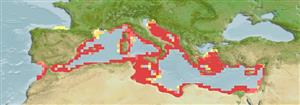Ελασμοβράγχιοι (καρχαρίες και σαλάχια) (sharks and rays) >
Rajiformes (Skates and rays) >
Rajidae (Skates)
Etymology: Raja: Latin, raja, -ae = a sting ray (Raja sp.) (Ref. 45335).
Environment: milieu / climate zone / εύρος βάθους / distribution range
Οικολογία
Θαλασσινό(ά) βενθικό(ς); εύρος βάθους ? - 300 m (Ref. 4426). Subtropical; 46°N - 30°N, 8°W - 36°E
Eastern Atlantic: known only from the Mediterranean but may penetrate through the Strait of Gibraltar and possibly to northern Morocco. Some Atlantic records probably misidentifications of Raja naevus and/or Raja africana.
Μέγεθος / Βάρος / Age
Γεννητική Ωρίμανση: Lm ? range ? - ? cm
Max length : 70.0 cm TL αρσενικό/απροσδιόριστο; (Ref. 4426)
Range from coastal waters to about 300 m depth (Ref. 3167). Feed on all kinds of bottom animals (Ref. 3167). Oviparous. Distinct pairing with embrace. Young may tend to follow large objects, such as their mother (Ref. 205). Eggs are oblong capsules with stiff pointed horns at the corners deposited in sandy or muddy flats (Ref. 205). About 80-154 eggs are laid by an individual in a year (Ref. 41305).
Life cycle and mating behavior
Γεννητική Ωρίμανση | Αναπαραγωγή | Γεννοβολία | Αβγά | Γονιμότητα | Προνύμφες
Oviparous, paired eggs are laid. Embryos feed solely on yolk (Ref. 50449). Spawns throughout the year with maximum number of egg-cases laid in late spring and summer, embryos developing in about 4 months (Ref. 3167). Distinct pairing with embrace. Young may tend to follow large objects, such as their mother (Ref. 205).
McEachran, J.D. and K.A. Dunn, 1998. Phylogenetic analysis of skates, a morphologically conservative clade of elasmobranchs (Chondrichthyes: Rajidae). Copeia 1998(2):271-290. (Ref. 27314)
IUCN Red List Status (Ref. 130435: Version 2025-1)
Threat to humans
Harmless
Human uses
αλιεία: Εμπορικό(ά)
Εργαλεία
Special reports
Download XML
Διαδικτυακές πηγές
Estimates based on models
Preferred temperature (Αναφ.
123201): 13.4 - 18.4, mean 15 °C (based on 128 cells).
Phylogenetic diversity index (Αναφ.
82804): PD
50 = 0.5000 [Uniqueness, from 0.5 = low to 2.0 = high].
Bayesian length-weight: a=0.00324 (0.00203 - 0.00515), b=3.20 (3.07 - 3.33), in cm total length, based on LWR estimates for this species & Genus-body shape (Ref.
93245).
Τροφικό Επίπεδο (Αναφ.
69278): 3.7 ±0.54 se; based on food items.
Ελαστικότητα (Αναφ.
120179): Χαμηλό, ελάχιστος χρόνος για διπλασιασμό πληθυσμού 4,5 - 14 έτη (Fec=80).
Fishing Vulnerability (Ref.
59153): Moderate to high vulnerability (48 of 100).
🛈
Nutrients (Ref.
124155): Calcium = 27.4 [5.4, 126.2] mg/100g; Iron = 0.815 [0.213, 2.369] mg/100g; Protein = 18.6 [15.3, 21.6] %; Omega3 = 0.723 [0.220, 2.585] g/100g; Selenium = 24.6 [7.1, 73.7] μg/100g; VitaminA = 9.78 [3.77, 24.88] μg/100g; Zinc = 0.587 [0.285, 1.067] mg/100g (wet weight);
